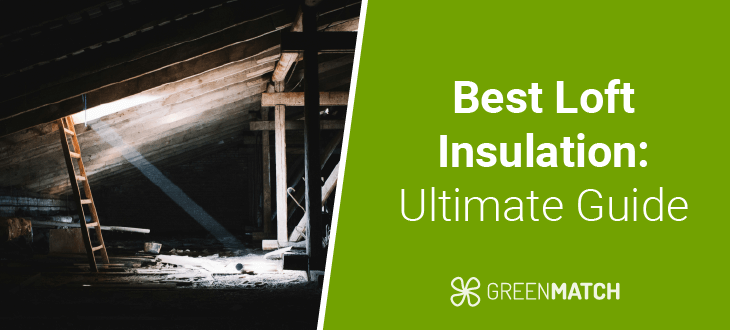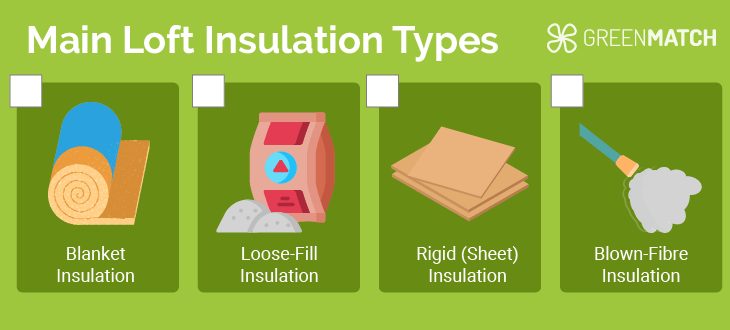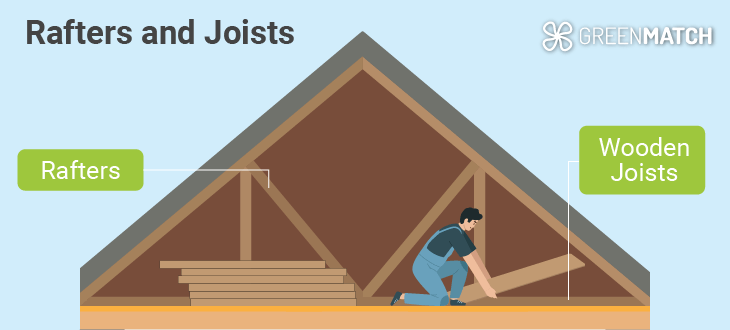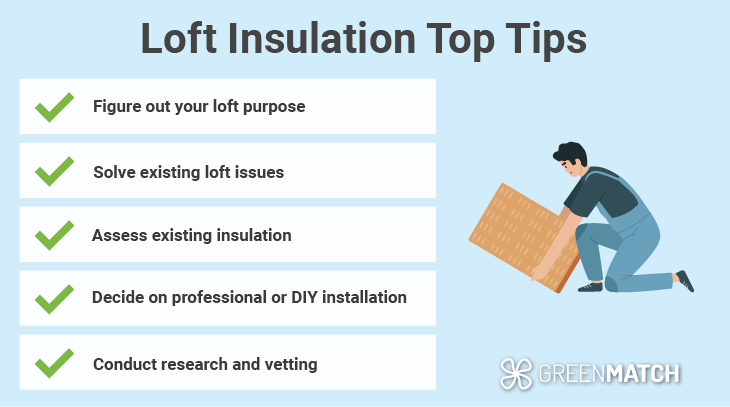Answer these simple questions and we will find you the BEST prices
Which type of solar quotes do you need?
It only takes 30 seconds
100% free with no obligation

Get Free quotes from insulation specialists near you

Save money by comparing quotes and choosing the most competitive offer

The service is 100% free and with no obligation
- GreenMatch
- Insulation
- Loft Insulation
- Best Loft Insulation
Best Loft Insulation: Guide, Types and Tips


- A detached UK household can lose up to £445 every year just through poor loft insulation.
- Uninsulated lofts can result in up to 1 tonne of yearly household CO2 emissions in a detached UK home.
- The most common and cost-effective loft insulation types are standard (blanket) insulation.
Uninsulated lofts comprise more than a quarter of a home's total heat loss, making loft insulation an absolute essential for all property owners. Alongside reducing your domestic carbon footprint by a staggering 1 tonne a year, loft insulation can bring about significant energy bill savings of up to £445 in detached homes and bungalows alone.
However, with all the options for loft insulation available on the market, choosing the best fit may seem like a daunting task. There are a variety of approaches to insulating a loft, each with its pros and cons, as well as suitability depending on your loft type, purpose and specifics.
In this complete guide, we’ll walk you through all of the main loft insulation options available on the market, as well as which types of loft insulation material are best suited for what purposes and jobs.
Ready to get your loft insulated? Look no further than GreenMatch UK to free you from the hassle of researching and vetting installers. Instead of spending hours a day on phone calls and websites, simply fill out our 30-second form and receive up to 3 free home-tailored quotes from our trusted installers in your area. No charges or obligations apply. Click below to begin!
- Describe your needs
- Get free quotes
- Choose the best offer
It only takes 30 seconds



What is the best loft insulation?
The best loft insulation for your home depends on many factors, most importantly what your existing loft is like, and what you want to achieve. The best insulation can also differ based on the quality you are comparing for, such as the best price, insulating effectiveness, or ease of installation.
To start, it's best to identify what you want to use your loft for, assuming you are to carry out a loft conversion insulation. This will largely determine the style of insulation you need. If you want to use your loft for storage purposes, you will likely require cold loft insulation, whereas if you want to use your loft as a living space, warm loft insulation is better suited to your needs. Both are discussed later in the article.
A loft insulation cost can vary greatly depending on several factors. When it comes to the best budget-friendly loft insulation, homes with existing good-condition insulation that fall short of the recommended 270mm thickness are in the best position. In some cases, homes have up to 100mm of previously installed insulation in place, which topping up costs much less than starting from scratch. For homes with outdated insulation, perhaps a loft insulation replacement is in order.
To get the best idea of what suits your needs as the best insulation material, let’s start by checking out the main types of insulation there are.
Main types of insulation

You may be wondering; what is the best loft insulation to use? Does loft insulation make a difference? Before answering that, let's become acquainted with the four main types of loft insulation that are available; standard (blanket), loose-fill, sheet, and blown-fibre insulation. Each approach comes with its perks and drawbacks, as well as suitability depending on loft conditions and personal preferences.
Standard (Blanket) insulation
Arguably the most popular, versatile and cost-effective insulation, these are blankets or rolls of insulating material that are laid in between the joists of your loft floor and roof rafters. They come in several materials, including eco-friendly options such as mineral wool (rock and glass), fibreglass, and even sheep’s wool.
- A budget-friendly option, normally costing no more than £10 per m2 for fibreglass.
- Very straightforward to install, and can even be done by yourself as a DIY project.
- Comes in many eco-friendly material options that are also recyclable.
- During installation, fibreglass and mineral wool can irritate when in contact with skin or eyes. Protective gear is needed to handle these materials.
- Blankets are not an ideal shape for insulating crevices and hard-to-reach loft areas.
- You need at least 270mm of blanket insulation to properly insulate your loft. Some other insulation materials are more effective, so less is required.
Loose-fill insulation
An eco-friendly insulator that comes as lightweight granules made from sustainable cellulose insulation, mineral wool, or cork amongst other options. It is applied by being blown into loft spaces with an applicator hose and is very useful when topping up existing insulation.
- Very effective in insulating hard-to-reach loft areas and crevices, making it one of the best options for inaccessible lofts.
- Most material options are entirely recyclable, such as cellulose which is made from recycled paper products.
- Fast and straightforward installation that only takes a few hours, ensuring your home environment isn’t disturbed for long.
- Loose-fill is more prone to settling and compression than other types of insulation, which risks loss of effectiveness in draughty lofts.
- Loose fill insulation cannot be done DIY and requires a professional to carry out the installation.
- Although cheaper than spray foam or blown fibre, loose-fill insulation is on the costlier side of insulation options.
Rigid (sheet) insulation
These rigid insulation boards are highly effective in heat retention and are usually applied to the insides of sloping roofs, or stud walls in lofts. They come in synthetic materials such as Polyisocyanurate (PIR) or expanded (EPS) and extruded (XEPS) Polystyrene. Greener eco-friendly alternatives include straw, cork, and wood-based boards.
- They have some of the most effective thermal properties of all insulation materials.
- Can easily be cut to size and even installed DIY, saving money on a professional.
- Not prone to compression or settling, making them very reliable and robust long-term solutions.
- Synthetic material boards like PIR are notoriously unsustainable and indispensable due to being plastic-based. They also consume a lot of energy in their production.
- Rigid insulation boards are some of the most expensive insulators on the market.
Blown-Fibre Insulation
This is a loose fibrous insulation material that is applied as blown in insulation. This is done with special industry equipment to reach hard-to-access lofts. It comes in several material types, most of which are eco-friendly and sustainable, such as cellulose, fibreglass, or mineral wool.
- One of the more eco-friendly insulation options that makes use of recycled materials.
- It tends to be more affordable than other insulators, with cellulose costing around £10 – £12 per m2.
- Very useful when insulating hard-to-reach loft areas, odd shapes and crevices.
- Requires to be installed by a professional using industry-specific equipment.
- Homes with dampness issues are largely unsuitable for blown fibre insulation as it is notorious for soaking up any moisture it is in contact with.
- Blown fibre insulation can dislodge or compress and settle if not installed properly, or if used in a loft with draught problems.
There are also sound insulation roof materials that differ a bit from thermal insulation materials if you are in the market for acoustic soundproofing.
Now that we’ve got a better understanding of the main types of loft insulation approaches, let’s look at which insulation is best suited for what purpose.
Best cold loft insulation
Cold loft insulation is a cost-effective and efficient solution for homes that don’t plan to use their loft as a living space. This is when your loft floor is insulated, ensuring that your home below stays warm. In this scenario, your loft itself remains uninsulated, but can still be used for storage purposes if it is safe and easy to access.
There are several approaches to cold loft insulation, and the best option will depend on your specific budget and needs:
- Standard (blanket and batt) insulation
This is one of the best cost-effective options available, with the best loft insulation rolls in terms of cost being mineral wool. Your floorboards are lifted, and 270mm of blanket insulation is laid between and over the joists. A 50mm air gap is left to ensure ventilation before the floorboards are put back in place. Most loft floors lack depth for the insulation and air gap, so loft legs/joist extenders are purchased to elevate the floorboards. These are in most hardware stores or can be handled by a professional.
Compressed batts instead of loose blankets are also available. They’re easy to fit, water-repellent, and breathable, making them ideal for minimising the risk of mould and rot.
- Rigid board insulation
This option is one of the most effective in retaining heat. The best loft insulation boards in terms of cost are Polystyrene (EPS) or PIR boards. Despite being costlier, rigid boards have far higher heat-retaining capabilities. Being half as thick as blanket insulation makes them very easy to install by fitting the boards in between your floor joists. Their slimness also means loft legs are unnecessary to raise floorboard height.
- Loose-fill insulation
This option is best for lofts with existing insulation. Some lofts may already have insulation in place that is in good condition, but less than the recommended thickness of 270mm. Loose fill is a great solution that comes in bags and can simply be poured on top and in sparse areas. It is a very easy task that requires no professional installer if simply topping up.
Best warm loft insulation
Warm loft insulation is best if you intend to use your loft as a living space, but is more complex and costly than cold loft insulation. Loft insulation between rafters will ensure that your loft space retains heat along with the rest of your home.
This process involves insulating your roof rafters from the inside, as well as the stud walls of your living space to make sure heat does not escape to the uninsulated parts of your loft. Windows or skylights will also need quality glazing and draught-proofing.
There are several approaches to insulating your roof rafters and stud walls, each with its perks. Let's take a look at some of the best options:
- Standard (blanket) insulation
This option again emerges as one of the most cost-effective options for loft insulation due to its wide availability and versatility. Coming in the form of blankets or batts (slabs) of mineral wool, fibreglass, or sheep wool, these can be installed in between your roof rafters and secured in place with netting before the plasterboard is added. The same can be done for stud walls.
The best loft insulation roll in terms of affordability is mineral wool, whereas sheep’s wool is the most effective in retaining heat.
- Rigid board insulation
Just like in cold loft insulation, rigid boards are one of the most effective in retaining heat in your loft. Being very DIY-friendly, you can cut this loft insulation into the desired width and secure it between your roof rafters and behind stud walls before being covered with plasterboard to insulate the loft living space. While the costlier option, rigid boards are highly effective.
- Spray foam insulation
Perhaps the most effective heat-retaining insulation on the market, spray foam is a synthetic expanding foam made from polyurethane and boasts some of the highest performance of all insulators on the market. It’s typically applied by being sprayed between the rafters from the inner roof of the loft. The downside is that it is very costly, unsustainable, and requires a professional installation.
So with all things considered, what is the best loft insulation to buy? If you are looking for the most cost-effective option that still successfully retains heat, then rolls of glass mineral wool would be your cheapest option. If budget isn’t a concern and you want the highest heat retention capacity possible, then spray foam insulation would be the way to go.
Best loft insulation material for rafters vs joists

The best loft insulation material between rafters and joists will depend a lot on your budget, personal preferences, and the type of loft you are trying to have; a storage space or a living space.
Rafters are the structural beams that support a roof structure or deck. They are normally vertical and common in traditional sloped roofs. Joists are structural beams that support floors and ceilings. They are normally horizontal.
Insulating between joists is generally the more common and cheap method of insulation, but will leave your loft space uninsulated. It’s a relatively straightforward process in which insulating material (usually blanket insulation) is laid in the joists and covered with floorboards.
Loft insulation between rafters is a great step if you plan to use your loft as a living space. In general, it's advised to insulate both your joists and rafters if the loft space accommodates more than just storage.
Here are some ways you could do just that:
- Sheep's wool
One of the most eco-friendly and sustainable approaches to standard (blanket) insulation is to use treated sheep wool. With higher heat retention than fibreglass and mineral wool, sheep wool is all-natural and recyclable, making it one of the best loft insulation between joists and rafters. You must source ‘treated’ wool so that it’s insect-resistant.
- Foil insulation
Single or multi-layer foil is an aluminium-based sheet that is one of the most affordable and easiest-to-install approaches to loft insulation. It typically has two or more aluminium layers bonded to layers of foam insulation and can reflect up to 97% of radiant heat, making it a formidable choice for rafter and joist insulation.
Tips for choosing the best loft insulation material

If you’re trying to figure out which is the best loft insulation material for your loft, you’ll need to identify what you’re working with and the needs that you have. From budget to loft type, there’s a whole range of factors to consider. Understanding these needs and the conditions of the loft you have will help narrow down your choices.
Additionally, you might wonder, is loft insulation fireproof? Fire safety is a paramount concern for homeowners, and knowing the fire resistance of your insulation material is crucial.
Here are our top tips to make sure you land the best loft insulation material for your needs:
- Figure out your loft purpose
Figuring out what you want to use your loft for is essential in narrowing down your insulation options. As mentioned before, storage lofts can suffice with cold loft insulation, whereas living space lofts will require warm loft insulation, which is a longer and more costly process.
- Solve existing loft issues
Lofts that have issues with draught, dampness or mould must first identify and solve these problems before installing insulation. This is to make sure the material you install doesn't become damaged and ineffective, as well as to protect the structural integrity of your house.
- Assess existing insulation
If your loft already has previously installed insulation in place, it’s best to get it professionally assessed for effectiveness. If it is still dry and in good shape, your best insulation choice could be to simply top it up to the recommended 270mm thickness with some loose fill insulation, both cost and time-effective.
- Decide on professional or DIY installation
Deciding whether to install with a professional or by yourself can narrow down your insulation material choice, as some insulation materials can only be installed by professionals. While a DIY loft insulation installation can cost two to three times less, professional loft insulation companies can ensure the job is done right and within loft insulation regulations, giving you peace of mind for decades to come.
- Conduct research and vetting
Perhaps the most important tip we have is to not shy away from digging deep into some research. By reading reviews of insulation materials and professional installers in your area, contacting previous clients and comparing multiple quotes, you give yourself the greatest shot and land the best insulation material and bargain for the installation.
While easier said than done, researching and vetting can have you stuck in an endless cycle of phone calls and websites with no end in sight. Here at GreenMatch UK, we’d love to free you from the burden by handling the work for you!
By filling out our simple 30-second form, you can receive up to 3 free home-tailored quotes from our trusted network of professional installers in your area. The best part? Our services are completely free and with no obligation to accept any quotes. Maximise your chances at the best bargain and click below to begin!
- Describe your needs
- Get free quotes
- Choose the best offer
It only takes 30 seconds



FAQ
The most effective loft insulation type is most likely spray foam insulation. It boasts some of the highest heat retaining capabilities but is also very expensive, not eco-friendly, and requires a professional installation. A better sustainable alternative is treated sheep wool, which is far more effective than its other blanket insulation counterparts and fully recyclable.
Thicker loft insulation is better if you have less than the government-recommended 270mm loft insulation thickness. This mostly applies to standard (blanket) insulation. If you already have loft insulation in place that falls short of this thickness, you can save money by simply topping up to 270mm by purchasing loose-fill insulation and adding it on top.
You don’t necessarily need to remove old insulation before laying a new one. This will depend on the condition of your existing insulation. If it is dry and healthy, topping up is a much more cost-effective approach to improving your loft insulation. Consult with a professional to check the condition of your existing insulation.
The optimum depth for insulation is said to be around 270mm to 300mm, provided there is adequate space for ventilation as well. At some point, adding further insulation will make little difference to your loft’s heat retention.
The best loft insulation thickness is around 270mm to 300mm of loft insulation, most often being standard (blanket) insulation. Topping up to 300mm will likely improve your loft insulation, provided that there is plenty of ventilation as well.
The UK government recommends that lofts are insulated with at least 270mm loft insulation thickness, mostly applying to standard (blanket) insulation. However, topping up to 300mm with adequate ventilation may further improve your loft’s insulating capacity.
300mm of loft insulation is the higher end of the recommended 270mm to 300mm of loft insulation. Topping up to this amount will likely improve your loft’s insulation capacity, but not by that much more.
There is not one best insulating material type, as this will depend on your type of loft, budget, and personal preferences. The most popular type of insulation, however, is standard (blanket) insulation, made of mineral wool, fibreglass, or sheep wool and fitted in between the joists and rafters of your loft.

Akif is a copywriter at GreenMatch since 2023. With a keen interest in community sustainability, green solutions and the role of digital media in identifying climate trends, he aims to hone in on his background in International Studies and Digital Media to provide a multidisciplinary approach to written content rooted in credible research and accuracy.
We strive to connect our customers with the right product and supplier. Would you like to be part of GreenMatch?

